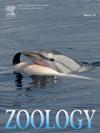Musculoskeletal comparison of the pectoral fin in mudskippers (Gobiidae: Oxudercinae)
IF 1.6
3区 生物学
Q2 ZOOLOGY
引用次数: 0
Abstract
Shifting of the locomotor mode from an aquatic thrust to a ground reaction force enabled vertebrates moving on land, which happened at the same time as fin-to-limb evolution. Early stages of this evolution are little known due to scattered fossil records. Oxudercine gobies, exhibiting the full spectrum of terrestriality and terrestrial locomotor behavior, provide a unique window to understand how the form and function of the pectoral fins were modified during the water-to-land transition. In the present study, the musculoskeletal system of pectoral fins of three mudskippers [Oxuderces nexipinnis (low terrestrial), Scartelaos histophorus (moderate terrestrial), and Periophthalmodon septemradiatus (high terrestrial)] and the out-group species (Oxyeleotris urophthalmus) were examined. There are some anatomical modifications endowing crutching on land including: the robust and triangular cleithrum; the stiff and elongated radials and fin rays; the development of the coracoid process, the radial process, and the coraco-radialis; the two hinge-like structures; the differentiated muscular system inclining in various angles; and well-developed adductor muscles. These configurations are correlated with the degree of terrestriality. Of these anatomical modifications, the presence of the coracoid process, the radial process, and the coraco-radialis could endow terrestrial movement in early oxudercine gobies. In addition, fin rays of early oxudercine gobies could prevent them from sinking into the unconsolidated substrates which could be analogous to the condition in sarcopterygian fishes. In general, this study shows the gradual evolution of the muscular and skeletal systems of the pectoral fins in the oxudercine gobies during water-to-land transitions.
弹涂鱼胸鳍肌肉骨骼的比较(虾蛄科:弹涂鱼科)。
运动模式从水中推力转变为地面反作用力,使脊椎动物能够在陆地上移动,这与鳍到四肢的进化同时发生。由于零散的化石记录,这种进化的早期阶段鲜为人知。虎虾虎鱼表现出全方位的陆地生活和陆地运动行为,为了解胸鳍的形式和功能在水到陆地的转变过程中是如何改变的提供了一个独特的窗口。本文对三种弹涂鱼(低陆生)、中陆生和高陆生)的胸鳍肌肉骨骼系统和外群种(urophthalmus Oxyeleotris)进行了研究。一些解剖学上的变化赋予了陆地上的拐杖,包括:坚固的三角形楔骨;刚硬而细长的径向和鳍形;喙突、桡突和喙桡肌的发育;两个铰链状结构;倾斜的肌肉系统:呈不同角度倾斜的分化的肌肉系统;和发达的内收肌。这些构造与陆地的程度有关。其中,喙突、桡突和喙桡肌的出现使早期虎虾虎鱼具有陆地运动的特征。此外,早期虎鱼的鳍射线可以防止它们沉入松散的底物中,这可能类似于肉鳍鱼的情况。总的来说,这项研究表明,在水到陆地的过渡过程中,虎虾鱼胸鳍的肌肉和骨骼系统是逐渐进化的。
本文章由计算机程序翻译,如有差异,请以英文原文为准。
求助全文
约1分钟内获得全文
求助全文
来源期刊

Zoology
生物-动物学
CiteScore
3.90
自引率
0.00%
发文量
37
审稿时长
70 days
期刊介绍:
Zoology is a journal devoted to experimental and comparative animal science. It presents a common forum for all scientists who take an explicitly organism oriented and integrative approach to the study of animal form, function, development and evolution.
The journal invites papers that take a comparative or experimental approach to behavior and neurobiology, functional morphology, evolution and development, ecological physiology, and cell biology. Due to the increasing realization that animals exist only within a partnership with symbionts, Zoology encourages submissions of papers focused on the analysis of holobionts or metaorganisms as associations of the macroscopic host in synergistic interdependence with numerous microbial and eukaryotic species.
The editors and the editorial board are committed to presenting science at its best. The editorial team is regularly adjusting editorial practice to the ever changing field of animal biology.
 求助内容:
求助内容: 应助结果提醒方式:
应助结果提醒方式:


